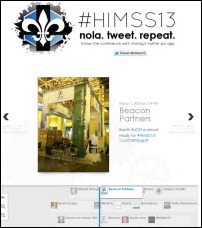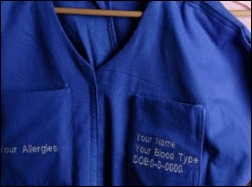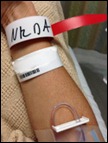From HIMSS 3/4/13
There’s no way I can catch up on the whole day since I’m starting at nearly 11 p.m. post-HIStalkapalooza time and the hotel Internet isn’t exactly screaming, so I will follow up later. Thanks to Medicomp Systems and their crew for putting together a great event; to our hosts, judges, contestants, and other participants; to Ross and Kym Martin for a great musical opening; for Jonathan Bush for another memorable HISsies presentation; and to everyone who came out to Rock ‘n’ Bowl. Lots of people were involved in arranging transportation, running the registration and coat check areas, setting up for the band, and working together to make sure everyone had the best time possible. We had some interesting attire, amazing shoes, and some truly lovely ladies and gentlemen both on the stage and off.
Welcome to new HIStalk Gold sponsor Strata Decision Technology. The company offers cloud-based financial analytics, business intelligence, and decision support, having integrated with EHRs (Cerner, Epic) and ERP (Lawson) systems. They do the integration and hosting, meaning the only IT time required is a couple of hours to coordinate. Customers get a single database and an integrated platform for operational budgeting, capital planning, financial forecasting, strategic planning, service line planning, cost accounting, contract analytics, and performance management. Provider organizations need to understand and manage true cost of care and margins that span episodes of care, service likes, and patient populations and Strata’s tools provide that capability. They’re not a recent addition to the analytics/BI landscape – they’ve been around 15 years. Customers include Cleveland Clinic, Hopkins, Yale, Allina, Duke, Legacy, Spectrum, and Intermountain. and they announced Mission Health (NC) as a new customer today from HIMSS. Thanks to Strata Decision Technology for supporting HIStalk.
I didn’t turn up any Strata videos on YouTube, but here’s one of CEO Dan Michelson (formerly of Allscripts) talking about a non-profit he started that hosts an annual benefit concert to send children who have been abused and neglected to overnight camp. The organization just received the “Innovation in Philanthropy Award” from the Make it Better Foundation.
Opening Session
There didn’t seem to be as much of the self-congratulatory HIMSS hoopla this time and I kind of missed that, to be honest. No looping slides listing committee members, fellows, etc. The brought in a high school marching band that seemed pretty good, but the airplane hangar acoustics make it hard to say for sure since all I heard were drums.
In an ironic moment, the teleprompter died while Willa Fields was speaking, forcing her to go back to paper.
The mayor gave a good speech. I don’t know what he’s like as mayor and he didn’t mention the fact that we were still under a boil water advisory (lifted soon after), but he was an engaging speaker and city cheerleader. He represented well. He mentioned that the city is investing $3 billion in a health complex for the VA, university hospitals, and some other players that I didn’t write down. It seemed confusing to be talking about spending all that money in the attempt to create healthcare jobs, but at the same time to be urging that we bend the cost curve (unless he meant up instead of down). Healthcare may create jobs, but it’s a drain on the economy, not a sustainable economic engine, and I found his message confusing. Healthcare can be maddening in that way as an odd mix of community pride, employment, comfort, and yet a crippling cost that someone has to pay.
The CEO of Ochsner was up next. He was pretty good, saying that only insurance companies have all the patient data from all locations, meaning we don’t really know our patients as well as they do. He pitched the idea that vendors need to not only cut their costs, but be on the hook to get paid only when their systems improve productivity. I think I would have put Bill Clinton in the opening keynote slot, but there’s a big HIMSS announcement coming Tuesday about their partnership with his foundation so they have him on Wednesday’s agenda.
Educational Sessions
Maybe it’s just me, but the educational component of the conference seems to be getting less and less interesting. I automatically don’t go to sessions that involve a vendor presenter, only because that always seems too much like a living white paper. Some sessions didn’t appeal to me, and one I attended didn’t appear to have any rigor at all behind it. I’ve served on the Annual Conference Education Committee in years past and I have to assume that they just don’t get that many submissions, leaving them no choice but to accept some iffy ones. It doesn’t help that they’ll be soliciting presentations in just a few days for next year’s conference, with the ridiculous year-long lead time. No wonder there’s nothing innovative being discussed – everything is at least a year old by definition.
I went to a VA-DoD session on iEHR, but it was more of an overview than anything newsworthy. Theresa Cullen, MD, MS of the VA was an engaging and personable speaker and I found her really likeable. She talked about the VA’s informatics programs, their role as the government’s living lab, and mentioned some of their research work, including in human factors. She described the Janus legacy viewer that will straddle the VA and DoD systems, which sounds almost like an HIE. They are still working through identity management problems.
The ONC Town Hall was fun because the ONC folks introduced themselves and their backgrounds and showed a more human side than you might typically picture.
There were a lot of bow ties being worked everywhere. It’s Farzad’s brand and it’s catching on.
Liaison Technologies was distributing fun add-on badge ribbons, as demonstrated by a reader’s photo.
An de-identified Dr. Jayne playing Quipstar in the Medicomp booth with her security detail. She didn’t win, but she was sassy and fun and she answered some tough questions. Everybody loves Dr. Jayne. Medicomp donated money to the charities designated by the players.
Here’s the Kaiser Permanente press release announcing the HISsies win of George Halvorson for the HIStalk Healthcare IT Lifetime Achievement award and Kaiser’s repeat win as best provider user. George’s son Seth and daughter-in-law accepted the award at HIStalkapalooza on his behalf. It’s nice recognition of both George and KP.
The big news of the day and maybe the whole conference was the formation of the Commonwell Health Alliance trade association by EHR rivals Allscripts, athenahealth, Cerner, Greenway, and McKesson (and its RelayHealth unit). They say they’ll promote data exchange among their systems and invite other vendors to join them. Notably missing from the list is Epic, whose commercial success surely had a role in bringing together its competitors.
Valence Health had a cool exhibit featuring a full-size school bus along with miniatures to give away. They had our booth sign out – thanks!
A very cool stuffed dragon giveaway by Workbeast. I got one, although I’m not exactly sure what I’m going to do with it.
The Aprima folks were sporting red vests. That’s our booth sign on the tabletop in green, signed by Inga, Dr. Jayne, and me.
Ladies from HITEKS giving out Mardi Gras beads. They were nice to pose for a picture.
Plantronics was giving out (and wearing) fun hats.
Booth observations:
- Teletracking had our HIStalk sign out and gave me a bendy stress reliever thing.
- Awarepoint was giving out cool water bottles. They had our sign out too, along with a decent crowd.
- Ascendian was mixing real margaritas (or so they said, anyway) but you had to get a coupon from a rep.
- iMDsoft had cookies and coffee. They gave me a demo of their anesthesia management system on an iPad and it was impressive. Best demo I’ve seen so far this week.
- Health Catalyst had a brilliant idea in giving reps iPad Minis preloaded with slides explaining the company. That allowed them to do a personal overview from anywhere one on one. That was quite effective.
- HyTrust had cookies.
- CPSI’s magician was wickedly funny, giving some competition to his always excellent Hyland OnBase counterpart outside their sports bar exhibit.
- Merge Healthcare had fresh fruit out, so I had an apple. That was a nice touch.
- Vitera had our sign out – thanks. Friendly folks there.
- MediQuant also had a good magician.
- Ingenious Med gave me a good, quick overview of their charge capture system.
- Greythorn had our sign out.
- Cerner had a big crowd.
- Beacon Partners had our sign out and the folks were deep in discussions with several groups.
- McKesson employees had their “Commonwell – we’re in” right after the announcement.
- First Databank had fancy coffee with flavorings. I don’t drink coffee, but it looked good.
- QuadraMed’s booth was set up nicely, with a living room setup on one side.
- A sign on Epic’s booth indicated that 66 percent of Stage 7 hospitals are on Epic, along with 100 percent of Stage 6 clinics. Judy was working the booth as usual.
- Passport Health did a nice job engaging me as I passed by and I noticed they had our sign out.
- The Allscripts boot was large and right across from Epic’s. Nice job. I like the green.
- MMRGlobal had a reasonable sized booth in a good location. I saw Bob Lorsch there.
- Healthagen had a two-story booth, one of not too many of those.
- Novell had someone making a variety of those hot cinnamon nuts you see at ball games. If your booth is near theirs, you no doubt got tired of the smell.
- SSI Group had their ladies dressed “Simply Irresistible” style, with pulled-back hair and bright red lipstick.
- Sandlot Solutions had our sign out and was using a projector to shine images on a large piece of clear glass. It’s hard to explain, but it was interesting.
- Rich Garcia from NextGate gave me a nice pitch when I feigned ignorance of their EMPI product. He played it perfectly based on my expressed interest.
- Alert and their folks in red striped white pants were there again, which always surprises me since I assume their EHR isn’t doing much here despite its European presence.
- Certify Data Systems had our sign out and was offering to donate $10 to the YMCA of New Orleans to each person who signed runner’s bib.
- Orchestrate Healthcare had our sign out. Lots of people were meeting in their booth.
- Quest/Care360 was offering pretzels with cheese sauce. They had our sign out.
- Wellsoft had our sign out – thanks.
Announcements
- API Healthcare announces The Healthcare Workforce Information Exchange, which allows health systems with multiple venues to share employee information across facilities.
- Texas Children’s Hospital announces a 15 percent reduction in unnecessary x-rays for pediatric asthma patients following implementation of Health Catalyst.
- Dell, Red Hat, Intel, and VMware announce the opening of the Wisconsin-based testing center for hospitals running Epic on Red Hat Enterprise Linux
- Epic and McKesson settle their patent litigation over MyChart, with McKesson granting Epic a license for its technology.
- Allscripts announces the winners of its Open App Challenge.
Photos from HIStalkapalooza
Dr. Gregg’s bowling shirt.
Farzad accepting his “When ___ Talks, People Listen” HISsies award.
Medicomp CEO Dave Lareau and Software Testing Solutions CEO Jennifer Lyle interview Bonny Roberts of Aventura on the red carpet.
Bonny with her “Mr. H’s Secret Crush” sash.
James Harris sent this pic of the Orion bowling team: David Leach, Tanya Niemeyer, and Paul deBazio.
A James Harris shot of Tom Visotsky, winner of Inga’s Secret Crush.
Food. I liked the jambalaya and etoufee.
That’s it for now since I’m tired and it’s late.
Contacts
Mr. H, Inga, Dr. Jayne, Dr. Gregg, Lt. Dan, Dr. Travis.
More news: HIStalk Practice, HIStalk Connect.
























































































It doesn't look like much more than a computer facing a wall!!